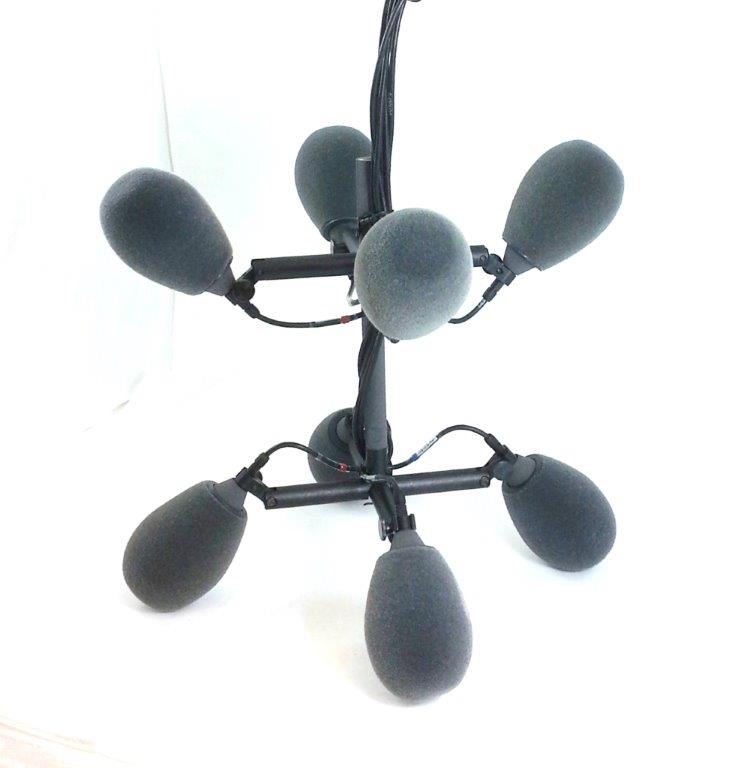Perhaps the multichannel systems developed for surround ambiance could be adapted to music recording. The 8-channel Schoeps ORTF-3D setup certainly looks like a good candidate, but I imagine the typical taper doesn't roll up with an $18k+ mic setup!
[edit] ^ except Mike Grace recording Phish at Red Rocks.[/edit]
I can't really image the stretch to recording and reproducing height information as well, except maybe binauraly via headphones. But most folks consider me crazy recording 6 channels for horizontal surround! I have a few ideas about what I feel would be more productive use of 8 recorded channels and have done a few tests, but still with a playback target of standard 2-channel, or 5 to 7 channel surround playback. I think I'm reaching the point of diminishing returns now, but I've thought (hoped?) that in the past before moving this far, yet the further additions were always too compelling to dismiss once I figured out how to take advantage of them.
I suppose if virtual binarual 3-D playback really takes hold and these kind of setup become available at reasonable cost in easy to use formats - plug a future low-cost ORTF-3D blimp competitor into your phone or something. But outside of the film and TV world where these tools are justified professionally, its hard to sell a quality system like the Schoeps ORTF-3D on the consumer market, when a smaller, more compact, far less costly and complex systems are available, even if the results aren't truly comparable. Small, low-cost and simple wins over quality most every time in the consumer world. People generally want something they can just plug in or stream to their phone. Convenience trumps quality.
But even if Schoeps ORTF-3D is totally over the top for tapers, you raise an interesting point. 8-channel ORTF-3D is basically two 4-channel ORTF-surround setups, one angled down, the other up. In turn, ORTF-surround is basically two back-to-back standard 2-channel ORTF setups. It's a straight geometric progression from 1D to 2D to 3D. Similarly IRT-cross is nothing more than two back-to-back DIN setups forming a square. It could also be extended to an 8-channel 3D cubic array.
Here's the prototype ORTF-3D setup as a cubic array, prior to squashing to something more compact and marketable (notice that it's using two standard IRT-cross mounting bars)-

A motivated taper could rig that up with inexpensive AT or CA mics into an F8 at around the same cost of a top-quality 2-channel Schoeps setup. These setups get costly because of channel count using quality microphones, but as logical extensions of the basic near-spaced 2-channel mic techniques, they aren't difficult to understand. We now have the recorders available at reasonable cost.
What that prototype really needs for music recording is a SchoepsCMIT shotgun extending forwards! I joke, but it's true. That thing takes care of the ambient stuff in a fully open and airy 3-D better than an ambisonic mic can (due to the more optimal spacing). Mix it with the SBD and or add a forward facing directional mic for the direct sound component to make it more music suitable.
But then you start optimizing for music recording with a preferred axis and that nice symetric cube becomes more and more stretched and distorted- the front mics point further to the sides to work correctly with the added center mic and so as not to not be overly dominated by the direct sound. You then approach the geometry of music oriented horizontal-surround configurations like Williams MMAD or OCT-surround setups.. or these odd-ball mishmash combinations of all these approaches.
I'm surprised I've not heard of any tapers dabbling in surround by simply pointing a second near-spaced stereo pair backwards behind their favorite forward facing near-spaced setup, especially the DMB tapers a decade back or so who were messing around with 4-channel surround and producing DTS encoded files. Just clamp a second DIN rig on the same stand facing backwards and run it all into a 4-channel recorder. No extra gear needed. Easy entry to quad surround and should be far better than the few DMB DTS surround attempts I've heard with SBD sent to the front speakers and AUD to the surrounds. If they had SBD, then route that to the center channel if they wanted to extend from quad to 5 channel in an acoustically optimal way, or stick with quad and mix the SBD in with the forward facing near-spaced L/R pair.